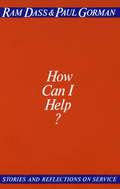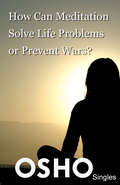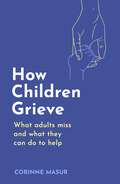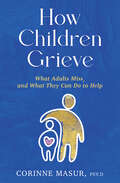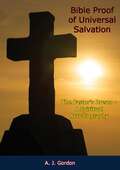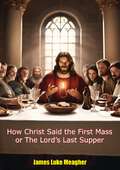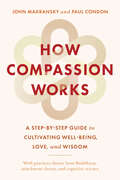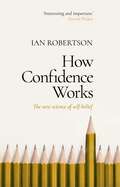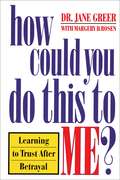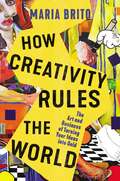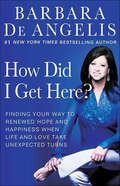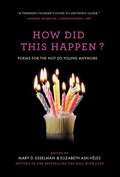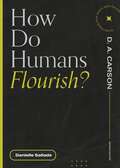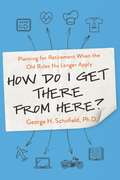- Table View
- List View
How Can I Help? Stories and Reflections on Service
by Ram Dass Paul GormanNot a day goes by without our being called upon to help one another--at home, at work, on the street, on the phone. . . . We do what we can. Yet so much comes up to complicate this natural response: "Will I have what it takes?" "How much is enough?" "How can I deal with suffering?" "And what really helps, anyway?"In this practical helper's companion, the authors explore a path through these confusions, and provide support and inspiration fo us in our efforts as members of the helping professions, as volunteers, as community activists, or simply as friends and family trying to meet each other's needs. Here too are deeply moving personal accounts: A housewife brings zoo animals to lift the spirits of nursing home residents; a nun tends the wounded on the first night of the Nicaraguan revolution; a police officer talks a desperate father out of leaping from a roof with his child; a nurse allows an infant to spend its last moments of life in her arms rather than on a hospital machine. From many such stories and the authors' reflections, we can find strength, clarity, and wisdom for those times when we are called on to care for one another. How Can I Help? reminds us just how much we have to give and how doing so can lead to some of the most joyous moments of our lives.From the Trade Paperback edition.
How Can I Help?: 8 Ways You Can Support Someone You Care About with Anxiety or Obsessional Problems
by Lauren CallaghanDo you have a friend, partner, child or loved one who’s suffering from anxiety? Do they need your help but you’re not quite sure what to do? Are you wondering how you can best support them?At some point in our lives, many of us will witness someone we’re close to experiencing anxiety, stress or anxiety-based depression. It can be challenging to see those you care about facing the challenges these conditions can cause, but there are ways that you can help. In this accessible, no-nonsense guide, clinical psychologist Lauren Callaghan provides tools, tips and strategies that you can use to help the person you love along the path to recovery. Whether your loved one has already been diagnosed, or whether you think that a loved one might be suffering but has not yet been diagnosed, there is something in here for you.
How Can Meditation Solve Life Problems or Prevent Wars?
by Osho Osho International FoundationThere are three kinds of problems - those that you create - they are almost ninety per cent of the problems of your life. You create them and you go on saying that you don't want them. Ninety percent of the problems simply disappear when you are in a meditative state - because you can see. And by seeing, you stop creating them. Ninety per cent will be solved; nine per cent will not be solved by your meditation but will be dissolved because they will not concern you at all. Seeing that it has nothing to do with you, that it does not arise in you, you have transcended it. One per cent remains. It has nothing to do with you or with others - that one per cent is part of existence itself.
How Champions Think: In Sports and in Life
by Dr. Bob RotellaAmerica’s preeminent sports psychologist delivers a groundbreaking guide to success in all aspects of life—not just sports—from business to relationships to personal challenges of every variety.Acclaimed sports psychologist Bob Rotella has advised everyone from professional golfers to NBA superstars to business executives on how to flourish under pressure and overcome challenges. Now, for the first time, he’s distilled his decades of in-depth research and practical experience into a potential-unlocking guide for everyone. This exciting book is not a collection of Rotella’s theories; it consists of performance principles that have proven themselves in countless competitive situations, in arenas from which only the strongest minds emerge triumphant. It’s a book full of insights that you can learn and use the next morning—in the office, the classroom, or wherever your quest takes you—told not in abstractions, but through case studies and stories drawn from Rotella’s years teaching sports psychology, counseling athletes, and consulting for Fortune 500 companies. It explores how to keep the mind from holding you back, whatever your physical gifts or other talents. It’s about how to make a commitment, how to persevere, how to deal with failure—and how to train your mind to create a self-image that promotes confidence and accomplishment. Any successful life starts with how you see yourself. And with these pearls of wisdom from the nation’s preeminent sports psychologist, you can learn to achieve the success of your dreams.
How Children Grieve: What Adults Miss And What They Can Do To Help
by Corinne MasurAn informative, empathetic and accessible guide to understanding childhood grief at every age, which will help caretakers to support children mourning after loss.From Dr Corinne Masur, an award-winning clinical psychologist specialising in grief and mourning, comes a necessary and impactful guide to understanding children's grief from the inside and to guiding children through loss, from the death of a parent and other family members, to the loss of friends, pets and even the family home. Dr Masur describes how to understand, help and guide children at each age and stage of development and uses her own childhood experience with loss through empathetic yet clinically informed advice.When Dr Masur was fourteen years old, her father died. Like most children and teens facing loss, Masur didn't know how to handle her grief, and she was never encouraged to acknowledge or share what she was feeling with her family, teachers or friends. Her experience of shock and emotional paralysis around her loss is what led her to become an expert in childhood grief in order to help grieving children and to help others to support the children in their lives who have experienced loss. As a psychologist and child psychoanalyst, Dr Masur has helped many children recognise and express their feelings after loss. In How Children Grieve, Masur shares her expertise with caregivers of all kinds, giving them the tools they need to help a child or teenager to mourn, to move forward and to make meaning of terrible loss.
How Children Grieve: What Adults Miss, and What They Can Do To Help: A Guide for Parents, Teachers, Therapists, and Caregivers to Help Children Deal with Death, Divorce, and Moving
by Corinne MasurUnderstand how children process grief at every age and stage of development in this accessible guide for parents and caretakers.An award-winning childhood grief expert shares clinically-informed advice for supporting kids and teens through difficult times—from family deaths and lost pets to unexpected moves, and beyond.A necessary and impactful guide to understanding children's grief from the inside and to guiding children through loss, from the death of a parent and other family members, to the loss of friends, pets, and even the family home. Dr. Masur, an award-winning clinical psychologist specializing in grief and mourning, describes how to understand, help, and guide children at each age and stage of development and uses her own childhood experience with loss through empathetic yet clinically informed advice.When Dr. Masur was fourteen years old, her father died. Like most children and teens facing loss, Masur didn&’t know how to handle her grief, and she was never encouraged to acknowledge or share what she was feeling with her family, teachers, or friends. Her experience of shock and emotional paralysis around her loss is what led her to become an expert in childhood grief in order to help grieving children and to help others to support the children in their lives who have experienced loss. As a psychologist and child psychoanalyst, Dr. Masur has helped many children recognize and express their feelings after loss. In How Children Grieve, Masur shares her expertise with caregivers of all kinds, giving them the tools they need to help a child or teenager mourn, move forward, and make meaning of terrible loss.
How Christ Came To Church: The Pastor's Dream - A Spiritual Autobiography
by A. J. GordonExperience a profound spiritual awakening with A. J. Gordon's How Christ Came to Church: The Pastor's Dream - A Spiritual Autobiography. This inspiring and deeply personal account offers a glimpse into the transformative journey of A. J. Gordon, a prominent 19th-century pastor, and theologian, whose life and ministry were profoundly changed by a vivid spiritual encounter.In this spiritual autobiography, Gordon recounts a remarkable dream in which Christ Himself appeared and attended his church. This divine visitation serves as the central theme around which Gordon reflects on his own spiritual growth, his calling to ministry, and the ways in which this extraordinary experience reshaped his approach to faith and leadership.How Christ Came to Church is more than just a retelling of a dream; it is a heartfelt exploration of the nature of true Christian ministry and the presence of Christ in the life of the believer. Gordon's narrative delves into the impact of this experience on his preaching, his pastoral care, and his personal devotion, offering readers a vivid portrayal of how a single moment of divine intervention can lead to a lifetime of spiritual renewal.Throughout the book, Gordon shares insights and reflections that are both deeply theological and intensely practical. His writing is imbued with a sense of humility and reverence, inviting readers to contemplate their own spiritual journeys and the presence of Christ in their lives. The book challenges readers to seek a more authentic and vibrant faith, grounded in a personal relationship with Jesus.How Christ Came to Church is an essential read for pastors, church leaders, and anyone longing for a deeper, more intimate experience of God’s presence. A. J. Gordon’s eloquent and heartfelt testimony continues to inspire and encourage believers to seek the transformative power of Christ in their own lives and communities.
How Christ Said the First Mass or The Lord's Last Supper: The Rites And Ceremonies, The Ritual And Liturgy, The Forms Of Divine Worship Christ Observed, When He Changed The Passover Into The Mass (classic Reprint)
by James Luke MeagherWORLDLY people look with wonder at the Mass, and often say: “What is the meaning of this form of divine worship? Where did these ceremonies come from? Why are candles lighted during daytime? Why do the priests wear such peculiar robes? Why don't they say the service in a language the people can understand?”The Catholic sometimes says to himself: “The Mass came from the Last Supper. But did Christ or the apostles say Mass as priest or bishop of our time? Did Christ that night follow any form of worship? If he did, where is it found? From ancient days the Church used the Ordinary of the Mass, but we do not know its origin.”Many questions rise in people's minds to which they find no answer. A common opinion holds that Christ said the First Mass at the Last Supper according to a short form of blessing and prayer, then consecrated the bread and wine, gave the apostles Communion, and preached the sermon John's Gospel gives. When the apostles said Mass, they recited some Psalms, read the Scriptures, preached a sermon, consecrated the bread and wine, recited the Lord's Prayer and then gave Communion. In the apostolic age the saints added other prayers and ceremonies. Afterwards Popes and councils still developed the rites, composed new prayers, and during the Middle Ages the Mass grew and expanded into the elaborate Liturgy and Ceremonial of our day.But these opinions are wrong. From the beginning the Mass was said according to a long Liturgy and with ceremonies differing little from those of our time. No substantial addition was made after the apostolic age; what the early Popes did was of minor importance, revisions and corrections. Little addition was made to the Ordinary of the Mass handed down from the days of Peter, founder of our Latin Liturgy.
How Come They're Happy and I'm Not?: The Complete Natural Program for Healing Depression for Good
by Peter BongiornoA proven, science-based, holistic approach to beating depression and feeling good—without medication—from the author of Put Anxiety Behind You. For many people who suffer from depression and anxiety, prescription drugs have either not been effective or have produced intolerable side effects. Now, naturopathic doctor and acupuncturist Peter Bongiorno, ND, LAc, offers a drug-free approach for healing depression in How Come They&’re Happy and I&’m Not. Bongiorno explains that depression and chronic low moods often have roots in physical ailments: inflammation, digestive problems, poor nutrient absorption, or disease. Depression can also be brought on by spiritual concerns, life events, or simply insufficient resources in dealing with day-to-day stress. Bongiorno&’s integrative, natural approach to psychology and healing, which he has used successfully with his own patients, features a personalized approach that includes: Working with your doctor to identify underlying causes of depression with blood tests and dietary changesBotanical medicines, yoga, massage, and acupuncture pointsA treatment plan based on your particular symptoms and circumstances
How Compassion Works: A Step-by-Step Guide to Cultivating Well-Being, Love, and Wisdom
by John Makransky Paul CondonUncover your innate capacity for love, presence, and wisdom with compassion training adapted from Tibetan Buddhism and contemporary psychology.Everything we care about—our mental and physical well-being, our relationships, our spiritual life, our ability to be useful to others—depends on our ability to access love and compassion within ourselves first. This clear, step-by-step guide offers a way to cultivate this power through an evidence-based meditation method called Sustainable Compassion Training (SCT). With practices drawn from Tibetan traditions, attachment theory, and cognitive science, How Compassion Works uses a progressive series of meditations to gradually build our capacity for mindfulness and presence—and to help us avoid empathic distress, compassion fatigue, or burnout. Organized into three categories—receptive mode, deepening mode, and inclusive mode—these practices help us cultivate unconditional care and discernment from within. With a flexible framework that allows practitioners to integrate their own religious or spiritual beliefs, this book offers practices suitable for people of all faiths and those seeking a purely secular path.
How Confidence Works: The new science of self-belief
by Ian Robertson* Confidence makes your brain work better and boosts your performance* Confidence acts like a mini-antidepressant, lifting your mood* Confidence is contagious* Confidence is anxiety's greatest antidote* Confidence is a set of habits that feel fake at first but become real with practice* Confidence makes boys bullsh*t more than girls* Overconfidence can have disastrous consequences_________'Brilliant ... it will change how you think about confidence.' Johann Hari'Important for everyone but crucial for women.' Mary Robinson'Interesting and important.' Steven Pinker__________Imagine we could discover something that could make us richer, healthier, longer-living, smarter, kinder, happier, more motivated and more innovative. Ridiculous, you might say... What is this elixir?Confidence.If you have it, it can empower you to reach heights you never thought possible. But if you don't, it can have a devastating effect on your future. Confidence lies at the core of what makes things happen.Exploring the science and neuroscience behind confidence that has emerged over the last decade, clinical psychologist and neuroscientist Professor Ian Robertson tells us how confidence plays out in our minds, our brains and indeed our bodies. He explains where it comes from and how it spreads - with extraordinary economic and political consequences. And why it's not necessarily something you are born with, but something that can be learned.__________'Rich stories and change-inspiring examples for every kind of performer.' Pippa Grange'Appealing... ranges from neuroscience to politics.' Nature
How Confucius Changed My Mind: And What He Can Teach You about the Art of Being Human
by Charles B. JonesA compelling exploration of humanity, morality, religious practice, and leading a good life based on traditional Confucian thought.In this exploration of humanity, morality, religious practice, and leading a good life based on traditional Confucian thought, you are invited on a path of transformation. The unexpected depths to be found in Confucianism surprised author Charles Jones when he began teaching East Asian religions to undergraduate students thirty years ago. It raised fascinating questions relevant to life today, like what does it mean to be human? To understand the Confucian answers to these questions, Jones familiarizes us with Confucius, his main successors, and the situations to which their writings responded.But this is not another textbook introduction to Chinese religion and thought. Jones is an engaging, inquisitive scholar and thought provocateur whose ideas address problems all of us face throughout our lives. By engaging with the Confucian ideas explored in this book, like rethinking &“human nature&” and uncovering cultural presuppositions previously unnoticed, you might discover new horizons and possibilities for your life that previously you never could have imagined. And you will discover Confucius in an all-new light as a profound shaper of modern thought as much as Aristotle and Lao-tzu—whose revolutionary ideas have the power to change your mind for the better.
How Could You Do That?!
by Dr Laura SchlessingerHow Could You Do That?! illustrates Dr. Laura Schlessinger's philosophy of personal responsibility through her usually provocative but always stimulating moral dialogues with callers about everyday ethical dilemmas.In her lively pull-no-punches style, Dr. Laura takes on the moral dilemmas of our time: from the mindless pursuit of pleasure and immediate gratification to taking the easy way out when those actions produce ugly or uncomfortable life-altering consequences. She demonstrates in no uncertain terms that personal values are never someone else's reponsibility but your own, and why choosing not to honor them actually compounds unhappiness. Finally she explains that by disciplining self-indulgence and rising above temptation we can discover the infinite pleasures, the true happiness, of the moral high ground.Dr. Laura delivers not only a compelling argument for an ethical approach to life but also an invaluable inspiration to rebuilding character, conscience, and courage. Here is a work that can make a genuine difference in the quality of your own life and the lives of those we love.
How Could You Do That?!
by Laura SchlessingerHow Could You Do That?! illustrates Dr. Laura Schlessinger's philosophy of personal responsibility through her usually provocative but always stimulating moral dialogues with callers about everyday ethical dilemmas. In her lively pull-no-punches style, Dr. Laura takes on the moral dilemmas of our time: from the mindless pursuit of pleasure and immediate gratification to taking the easy way out when those actions produce ugly or uncomfortable life-altering consequences. She demonstrates in no uncertain terms that personal values are never someone else's reponsibility but your own, and why choosing not to honor them actually compounds unhappiness. Finally she explains that by disciplining self-indulgence and rising above temptation we can discover the infinite pleasures, the true happiness, of the moral high ground. Dr. Laura delivers not only a compelling argument for an ethical approach to life but also an invaluable inspiration to rebuilding character, conscience, and courage. Here is a work that can make a genuine difference in the quality of your own life and the lives of those we love.
How Could You Do This to Me?
by Jane GreerAt one time or another we have all been betrayed by someone we trusted, all felt the sting of deceit and subsequent shattering of self-confidence. And when the people we count on betray our trust, the wound is deep and long-lasting.In How Could You Do This to Me?, Dr. Jane Greer teaches readers:the types of people who are more at risk of betrayal the warning signs of someone who is untrustworthy a process that helps decide whether a relationship is worth saving or whether it should be abandoned.Part One discusses the roots of trust, blind trust, and the reasons betrayers betray. Part Two reveals our betrayers' many faces: admirers, users, or rivals. Part Three focuses on the fallout from betrayal: confrontation, revenge, and betrayal, and talks about how you can learn to trust your judgment and others again.From the Trade Paperback edition.
How Creativity Rules the World: The Art and Business of Turning Your Ideas into Gold
by Maria BritoLearn to make creativity work for your career.Anyone, regardless of who you are or what you do, can cultivate the habits, actions, and attitudes that inspire creativity and foster innovation.Creativity is the key to innovation in any business. How Creativity Rules the World shows that, despite contrary beliefs, creativity is an inexhaustible resource that can be learned by anyone.This timeless guide promises to make the creative process of billion-dollar entrepreneurs and successful seven-figure artists accessible and actionable for you. With revealing studies and stories spanning business and art, this book is a deep dive into history, culture, psychology, science, and entrepreneurship; analyzing the elements used by some of the most creative minds throughout the last 600 years.In How Creativity Rules the World, you will learn how to:Overcome limiting thoughts and dispel myths about creativity.Understand creativity through concrete data, historical passages, and examples of modern entrepreneurship.Develop timeless habits, principles, and tools that worked six centuries ago and continue to work today.Employ creativity in an everyday context to produce extraordinary results.Contemporary art curator and writer of the popular newsletter, The Groove, Maria Brito discovered the power of creativity when she transitioned from being an unhappy Harvard-trained corporate lawyer to a thriving entrepreneur and innovator in the art world. After applying the principles in How Creativity Rules the World to her own business, Maria started teaching struggling professionals, ranging from entrepreneurs to artists to CEOs. Proven by her students&’ creative successes, Maria will guide you to strike gold with your ideas as well.There has never been a more crucial time than now to develop your creativity and your ability to innovate. Coming up with original ideas of value is today&’s most precious skill.
How Customers Think: Essential Insights into the Mind of the Market
by Gerald ZaltmanHow to unlock the hidden 95 percent of the customer's mind that traditional marketing methods have never reached. This title provides a practical synthesis of the cognitive sciences. Drawing heavily on psychology, neuroscience, sociology, and linguistics, Zaltman combines academic rigor with real-world results to offer highly accessible insights, based on his years of research and consulting work with large clients like Coca-Cola and Procter & Gamble. An all-new tool kit: Zaltman provides research tools - metaphor elicitation, response latency, and implicit association techniques, to name a few - that will be all-new to marketers, and demonstrates how innovators can use these tools to get clues from the subconscious when developing new products and finding new solutions, long before competitors do.
How Cycling Can Save the World
by Peter WalkerPeter Walker—reporter at the Guardian and curator of its popular bike blog—shows how the future of humanity depends on the bicycle. Car culture has ensnared much of the world—and it's no wonder. Convenience and comfort (as well as some clever lobbying) have made the car the transportation method of choice for generations. But as the world evolves, the high cost of the automobile is made clearer—with its dramatic effects on pollution, the way it cuts people off from their communities, and the alarming rate at which people are injured and killed in crashes. Walker argues that the simplest way to tackle many of these problems at once is with one of humankind's most perfect inventions—the bicycle. In How Cycling Can Save the World, Walker takes readers on a tour of cities like Copenhagen and Utrecht, where everyday cycling has taken root, demonstrating cycling’s proven effect on reducing smog and obesity, and improving quality of life and mental health. Interviews with public figures—such as Janette Sadik-Khan, who led the charge to create more pedestrian- and cyclist- friendly infrastructure in New York City—provide case studies on how it can be done, and prove that you can make a big change with just a few cycling lanes and a paradigm shift. Meticulously researched and incredibly inspiring, How Cycling Can Save the World delivers on its lofty promise and leads readers to the realization that cycling could not only save the world, but have a lasting and positive impact on their own lives.From the Trade Paperback edition.
How Did I Get Here?: Finding Your Way Back to God When Everything is Pulling You Away
by Christine CaineDo you feel lost? Disconnected? Like you&’re just going through the motions?When you don&’t know the next step to take, God&’s grace empowers you with a way forward. His hope offers an anchor for the soul and a way to get back on track. His faithfulness declares that wherever you are now, he is always ready to bring you home.As a respected Bible teacher, author, and activist, Christine Caine knew that Jesus was her only anchor. But after an especially difficult season, she found herself drifting, unsure if she wanted to keep going the way she always had and asking, &“How did I get here?&” as she struggled to return to the steadiness of God&’s purpose for her. Where she once wanted to take ground, she now just wanted to take cover. It was a bewildering and disorienting place to be—one you may also have found yourself in before.With refreshing candor and relatable humor, Christine offers biblical insights helping youidentify nine signs you are drifting off course and realign with God&’s purpose;ask the right questions about your relationships with God, others, and your own heart so you can stay anchored in truth despite the world&’s shifting currents;move from a what-if faith to an even-if faith as you discover how to trust God more deeply; andwrestle honestly with your soul&’s longings so we can respond to all the ways God answers—even when it feels like he doesn&’t.Writing for all who feel empty of the spiritual passion they once knew, Christine vulnerably shares her journey of turning her eyes back to Jesus in her thoughts, prayers, actions, and the hard questions she asked along the way.
How Did I Get Here?: Finding Your Way to Renewed Hope and Happiness When Life and Love Take Unexpected Turns
by Barbara De AngelisAll of us find ourselves, at one time or another facing the unexpected and asking "How did I get here?" Whether because of disappointments in love, crises in health, family or finances, professional dissatisfaction, or events beyond your control, life doesn't look like you expected or intended it to. HOW DID I GET HERE? is a groundbreaking inspirational handbook for anyone of any age going through change, challenge or reevaluation in any aspect of their lives. It is about finding your way to renewed hope and happiness from wherever you are. Renowned transformational teacher Barbara De Angelis masterfully guides you through an understanding of your own life lessons, and teaches you how to successfully use whatever you're going through as a springboard for regeneration and rebirth.We live in turbulent times of profound change, and many of us find ourselves at emotional and spiritual crossroads.HOW DID I GET HERE? offers illuminating teachings and practical, innovative techniques that free you to move forward into a life of renewed optimism, true contentment and courageous awakening. With her remarkable blend of timeless wisdom, practical techniques and down-to-earth advice, Barbara De Angelis helps you to : *Recognize and understand the significant transitions, turning points, and wake-up calls on your path *Transform fear into courage, confusion and into vision, and self-doubt into confidence *Turn what appear to be dead ends into doorways *Reclaim your passion and purpose for living and loving *Discover freedom, fulfillment and authenticity from the inside out Written with Barbara De Angelis' trademark eloquence, honesty and compassion, and containing the treasures of her own thirty-five year quest for enlightenment, HOW DID I GET HERE is a more than uplifting, intimate and moving--it is a true transformational manual for achieving emotional and spiritual rebirth that will change your life.
How Did I Get So Busy? The 28-day Plan to Free Your Time, Reclaim Your Schedule, and Reconnect with What Matters Most
by Valorie BurtonDo you feel stressed, overworked, like you're running on empty? Are you caught in the race to get it all done--with little time to enjoy the rewards life has to offer? There's no doubt about it: these days we are just too busy. With the conveniences of technology, we're compelled to get more done in less time and end up constantly striving for the next thing - rarely stopping to consider if it's something we even want. As a result, we end up missing out on the things that truly matter: our relationships, the activities we love, quiet time to reflect and replenish our energy. Valorie Burton's How Did I Get So Busy? is the solution for anyone who feels perpetually overwhelmed and overworked: a simple, effective 28-day program to help you rediscover your true priorities, shift out of overdrive, and reclaim your life and schedule. Built around Burton's "Ten Commandments of Self-Care," each day presents an easy-to-follow task to help you strip away the meaningless activities that occupy your time and make room for what nourishes you--mind, body, and spirit. The tasks are simple but yield big rewards: Take a full hour for lunch Set "no-email" periods Add fun goals to your to-do list End your day "on purpose" - meaning that you decide when to leave the office, head home, and fall asleep. Uplifting and inspiring, How Did I Get So Busy? offers an easy way to be rid of the busywork that fills our days and rediscover the life you've always wanted.
How Did This Happen?: Poems for the Not So Young Anymore
by Mary D. Esselman Elizabeth Ash VelezFrom the bestselling authors of The Hell with Love, a fierce, funny, touching collection that takes the sting out of "aging while female."
How Do Humans Flourish? (Questions for Restless Minds)
by Danielle SalladeExperience life under Jesus' yoke. Everyone wants to succeed in life. But do you know what success looks like? Is true flourishing found in a busy life pursuing money, status, and experiences? Or is there a better way? In How Do Humans Flourish?, Danielle Sallade argues that the Christian life leads to thriving. Many burden under the yoke of worldly success, resulting in stress, anxiety, and exhaustion. But true flourishing can be found only in peace, and that begins with a right relationship with God. Learn what true success looks like. Discover how you can value work rightly, find your identity in Christ, and live with an attitude of dependence on God. You too can flourish. The Questions for Restless Minds series applies God's word to today's issues. Each short book faces tough questions honestly and clearly, so you can think wisely, act with conviction, and become more like Christ.
How Do I Get There from Here?: Planning for Retirement When the Old Rules No Longer Apply
by George SchofieldNo matter how far or close you think you are to retirement, this book is your one-stop guide to help you plot your direction for the coming decades.Not long ago everyone knew what the word retirement meant--retire at age 65 after 40 years at the same job and coast through your golden years courtesy of a comfortable nest egg. But now, age expectancy is higher, savings are slimmer, and people change jobs more frequently. Clinging to this outdated concept of retirement only gets you a room in your kids&’ house. Your retirement is going to require an incremental approach to planning--and you must begin now. This requires conscious engagement, diverse interests, and the ability to adapt.In How Do I Get There from Here?, readers will first be directed how to review all their assets--both tangible and intangible--so they can get an honest assessment of where they are right now. Then a journey through self-reflective questions and exercises will:walk you through imagining your future,identifying skills you&’ll need,and learning how to prepare for inevitable twists and turns along the way.Stop clinging to an ancient and stereotypical idea of retirement. Decades of nonstop leisure is not only unreachable for most, it&’s not even truly desirable. Begin now charting the path for a unique, dynamic future you can look forward to!
How Do I Sexy?: A Guide for Trans and Nonbinary Queers
by Mx. Nillin LoreWhat even is "sexy," and how do you do it? A tough question for trans and nonbinary queers struggling to find their sexual selves in a landscape rife with misogynistic, transphobic and homophobic ideals and expectations. In How Do I Sexy?, Mx. Nillin Lore provides affirming and helpful direction based on over a decade of their own personal and professional experience as an educator, advocate, support worker and award-winning sex blogger. You're invited to do some deep introspection, find a look that feels right and gain insight on sexiness from fellow trans and nonbinary queers. You'll also find valuable tips on navigating dating sites, finding community, managing rejection with grace and engaging in sexual relationships. Principled and compassionate, Mx. Nillin Lore will help you figure out who you want to be, who you want to be with and how to make it happen— both in the streets and between the sheets.
